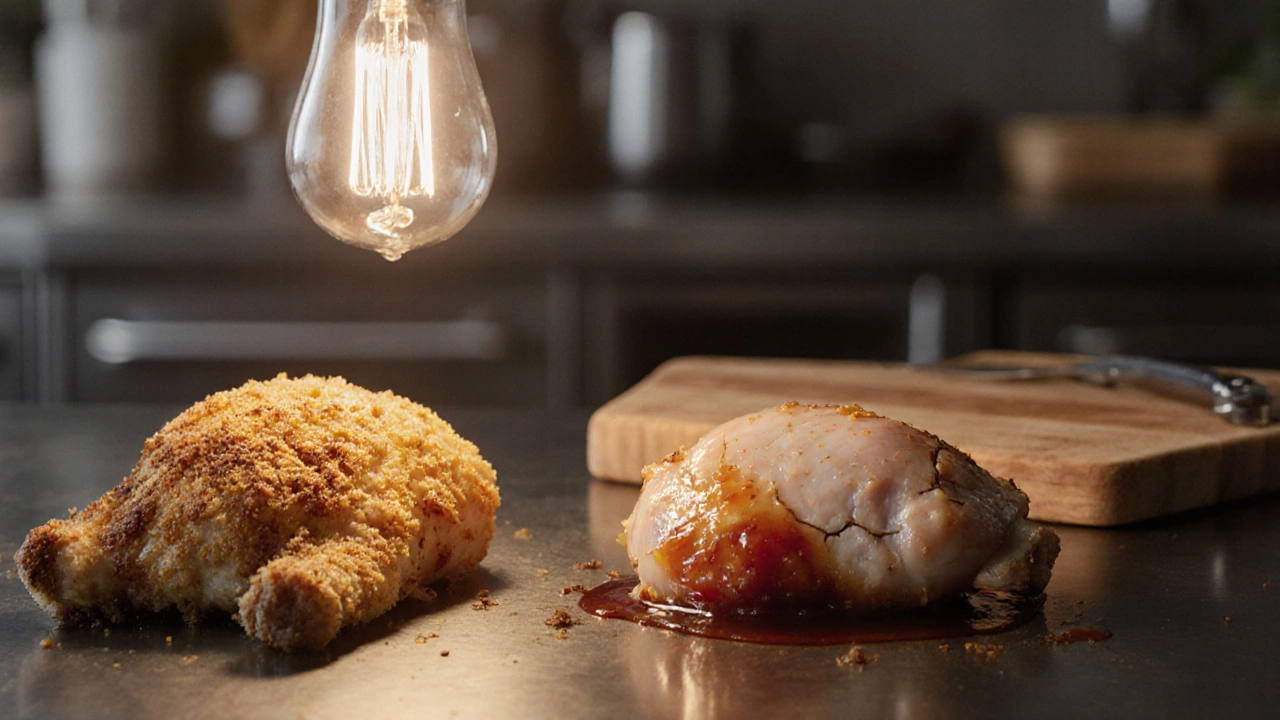Moist Chicken: Tips for Juicy, Tender Poultry
When working with Moist Chicken, poultry that stays juicy and tender after cooking. Also known as juicy chicken, it’s the goal of home cooks who want flavor without dryness.
One key method is roasting chicken, a high‑heat technique that creates crispy skin while locking in moisture. Another popular approach uses a slow cooker, a low‑temperature appliance that gently cooks meat for hours. For extra safety and flavor, many chefs add a brine, a salt‑water solution that seasons the meat from the inside out. These three tools together form a solid foundation for achieving truly moist chicken. If you’re after moist chicken, keep reading.
Mastering Roasting Chicken Without Drying It Out
Roasting starts with a hot oven, usually 425°F (220°C). The high heat sears the outer layer, forming a barrier that traps juices. A simple trick is to pat the bird dry, rub it with oil, and season generously. Basting every 20 minutes with its own juices or a butter mix adds a thin moisture layer and promotes even browning. The internal temperature should hit 165°F (74°C) at the thickest part; using a meat thermometer prevents overcooking. Let the chicken rest for at least 10 minutes before carving – this lets the juices redistribute, so every bite stays moist.
Many home cooks skip the rest step, slicing right away and watching the juices run out. That’s a common mistake that turns a perfectly roasted bird into a dry disappointment. Resting also makes carving easier because the meat firms up just enough to hold together.
When the oven’s heat is too low, the skin never crisps and moisture escapes as steam. Aim for a hot start, then lower the temperature slightly after the first 15 minutes if the bird is large. This balance creates a golden crust and a juicy interior.
These roasting basics link directly back to moist chicken: a sealed surface, controlled temperature, and a brief rest period are the three pillars that keep poultry from drying out.
Beyond the oven, the slow cooker offers a hands‑off way to lock in moisture.
Using a slow cooker, the low, steady heat cooks the chicken gently, preventing the proteins from tightening too fast is perfect for busy days. Set the cooker on low for 6‑8 hours or on high for 3‑4 hours. The secret is to add a liquid – broth, water, or a sauce – that creates steam and keeps the meat bathed in moisture. Because the temperature never exceeds 200°F (93°C), the meat stays tender and falls off the bone.
One tip many overlook is to avoid over‑filling the pot. Leave a inch of space so steam can circulate. Also, sear the chicken first in a pan; this adds flavor and a bit of color that the slow cooker alone can’t achieve. When the cooking cycle ends, let the chicken sit for 10 minutes in its juices before serving – the same rest principle used in roasting.
Another powerful moisture‑boosting method is brining. Submerging the bird in a salt‑water solution for a few hours (or overnight for larger birds) changes the meat’s chemistry. The salt draws water in, and the proteins unwind, allowing them to re‑absorb the liquid. The result is chicken that stays juicy even after high‑heat cooking.
To make a basic brine, dissolve 1/4 cup of kosher salt in 4 cups of water, add a tablespoon of sugar, and throw in aromatics like garlic, peppercorns, or herbs. Let the chicken sit in the brine, then pat it dry before roasting or slow‑cooking. This extra step adds flavor depth and helps prevent dryness.
Seasonings play a role, too. Our site, Spice & Sizzle, loves pairing heat with moisture. A dash of chili powder or cayenne on a brined, roasted chicken creates a tasty contrast: the spice lifts the flavor while the meat stays succulent. The heat doesn’t evaporate the juices; it simply adds another layer of taste.
Equipment matters as well. A reliable meat thermometer gives you the exact moment the chicken reaches safe temperature without guessing. An instant‑read model takes seconds, letting you pull the bird out of the oven or cooker at the perfect point.
Finally, keep an eye on common pitfalls. Cutting into the chicken too early releases steam and liquid, drying the meat. Using too much high‑heat oil can cause the skin to burn before the interior cooks. And forgetting to account for bone‑in pieces can lead to uneven cooking – always add a few extra minutes for bone‑filled cuts.
All these techniques – proper roasting, slow‑cooking, brining, seasoning, and tool use – intertwine to create the ultimate moist chicken experience. Below you’ll find a curated selection of articles that dive deeper into each method, share recipes, and offer step‑by‑step guides so you can put these ideas into practice right away.
How to Keep Oven-Baked Chicken Juicy Every Time


